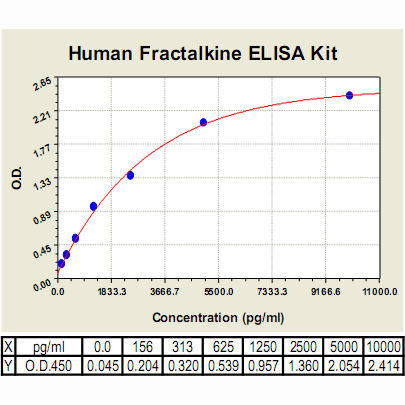Fractalkine ELISA Kit, Human |
 |
BACKGROUND The chemoattractant cytokines (chemokines) are ubiquitous chemotactic molecules that play major roles in acute and chronic inflammatory conditions. They are divided into 4 families defined by the number of amino acids between the N-terminal cysteine residues (CC, CXC, CCX, and CX3C). The largest families are the CC and the CXC chemokines. The CXC chemokine family is a pleiotropic family of molecules that are involved in the trafficking of various leukocyte subsets, angiogenesis, and vascular remodeling.1
Fractalkine (FKN, CX3CL1) is a unique, membrane-bound chemokine, with a transmembrane domain and the chemokine domain on top of a long mucinlike stalk. FKN shares high homology with the CC family of chemokines, but presents three amino acids between the first two cysteine residues (the CX3C structural motif). The molecule can exist in two forms, membrane-anchored or shed soluble glycoprotein, after extracellular proteolysis at a membrane-proximal dibasic cleavage site, similar to cleavage of syndecans. Each form mediates distinct biological actions. The membrane-anchored protein, which is expressed primarily on the inflamed endothelium, serves as an adhesion protein promoting the retention of monocytes and T cells. The soluble form resembles more a conventional chemokine and strongly induces chemotaxis. Both chemotaxis and adhesion are mediated by the Pertussis toxin–sensitive G protein–coupled receptor CX3CR1(corresponding to the orphan receptor previously named V28). CX3CR1 is capable of inducing locomotion and mobilization of intracellular calcium and activates the heterotrimeric G proteins, which mediate both leukocyte migration and adhesion. Firm adhesion is not inhibited by Pertussis toxin under static and physiologic flow conditions in monocytes, T cells, and natural killer (NK) cells. FKN was initially described as being expressed on IL-1– and TNF-activated endothelial cells (ECs) and having a wide mRNA distribution in human and murine tissues.2 Based on these chemotactic and adhesive properties, CX3CL1 has been suggested to play an important role in inflammation and accumulating evidence indicates that CX3CL1/CX3CR1 are involved in the pathogenesis of various inflammatory disorders. Moreover, it was also shown that the CX3CL1/CX3CR1 dyad may contribute to atherogenesis and plaque destabilization in human coronary artery disease.3 In addition, it was shown that CX3CL1 negatively modulates AMPA receptor function at active glutamatergic synapses through cell-signaling pathways by influencing the balance between kinase and phosphatase activity.4
Fractalkine (FKN, CX3CL1) is a unique, membrane-bound chemokine, with a transmembrane domain and the chemokine domain on top of a long mucinlike stalk. FKN shares high homology with the CC family of chemokines, but presents three amino acids between the first two cysteine residues (the CX3C structural motif). The molecule can exist in two forms, membrane-anchored or shed soluble glycoprotein, after extracellular proteolysis at a membrane-proximal dibasic cleavage site, similar to cleavage of syndecans. Each form mediates distinct biological actions. The membrane-anchored protein, which is expressed primarily on the inflamed endothelium, serves as an adhesion protein promoting the retention of monocytes and T cells. The soluble form resembles more a conventional chemokine and strongly induces chemotaxis. Both chemotaxis and adhesion are mediated by the Pertussis toxin–sensitive G protein–coupled receptor CX3CR1(corresponding to the orphan receptor previously named V28). CX3CR1 is capable of inducing locomotion and mobilization of intracellular calcium and activates the heterotrimeric G proteins, which mediate both leukocyte migration and adhesion. Firm adhesion is not inhibited by Pertussis toxin under static and physiologic flow conditions in monocytes, T cells, and natural killer (NK) cells. FKN was initially described as being expressed on IL-1– and TNF-activated endothelial cells (ECs) and having a wide mRNA distribution in human and murine tissues.2 Based on these chemotactic and adhesive properties, CX3CL1 has been suggested to play an important role in inflammation and accumulating evidence indicates that CX3CL1/CX3CR1 are involved in the pathogenesis of various inflammatory disorders. Moreover, it was also shown that the CX3CL1/CX3CR1 dyad may contribute to atherogenesis and plaque destabilization in human coronary artery disease.3 In addition, it was shown that CX3CL1 negatively modulates AMPA receptor function at active glutamatergic synapses through cell-signaling pathways by influencing the balance between kinase and phosphatase activity.4
REFERENCES
1. Liu, L. et al: Curr Top Dev Biol. 68:149-81, 2005
2. Fraticelli, P. et al: J. Clin. Invest. 107:1173–81, 2001
3. Teupser, D. et al: Proc. Natl. Acad. Sci. USA 101:17795-800, 2004
4. Ragozzino, D. et al: J. Neurosci. 26;10488-98, 2006
2. Fraticelli, P. et al: J. Clin. Invest. 107:1173–81, 2001
3. Teupser, D. et al: Proc. Natl. Acad. Sci. USA 101:17795-800, 2004
4. Ragozzino, D. et al: J. Neurosci. 26;10488-98, 2006
Products are for research use only. They are not intended for human, animal, or diagnostic applications.
Параметры
Cat.No.: | CL0356 |
Target Protein Species: | Human |
Range: | 156 pg/ml – 10000pg/ml |
Specificity: | No detectable cross-reactivity with any other cytokines |
Storage: | Store at 4°C. Use within 6 months. |
ELISA Kits are based on standard sandwich enzyme-linked immunosorbent assay technology. Freshly prepared standards, samples, and solutions are recommended for best results.
Документы
Информация представлена исключительно в ознакомительных целях и ни при каких условиях не является публичной офертой








